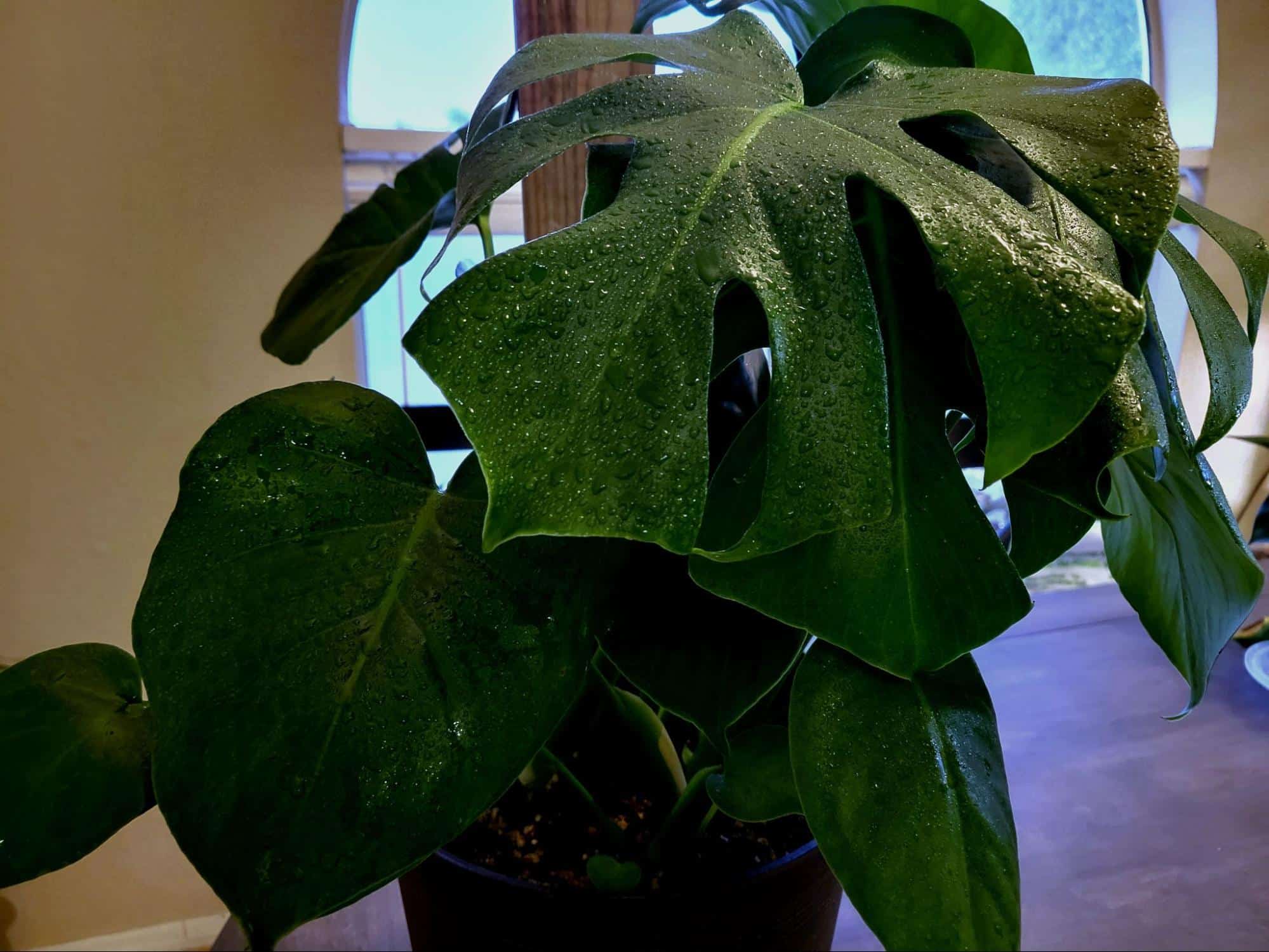Now that we’ve figured out how to grow huge tropical plants in our homes, houseplants with large leaves are permanently trendy. Let’s face it; they’re gorgeous and calming, and they make a bold statement literally anywhere. If you’re after a lush, tropical aesthetic, then consider grabbing a few plants with larger-than-average foliage.
An added benefit of plants with huge leaves is that they can help clean indoor air and make you feel calm and tranquil. There have even been studies that show that keeping many plants with large leaves can help keep indoor air cooler, at least by a few degrees. Besides- what’s better than the look of natural sunlight through a sea of green?
Houseplants With Large Foliage
Generally, plants with large leaves are adapted to humid rainforest climates. They can vary from cold rainforests to warm ones, but most indoor plants with large leaves are considered tropical. Without all the extra moisture, these plants wouldn’t be able to sustain their enormous leaves- which also happen to be an adaptation for efficiently soaking up sunlight, which they need lots of.
Rainforests aside, it can be hard to find the perfect plants to fit your space, though. Not every plant works well in every room, especially when it comes to light, care, and aesthetics. We rounded up all of our favorite houseplants with large leaves to help you choose the right plants to fit your space (and style).
Banana Tree
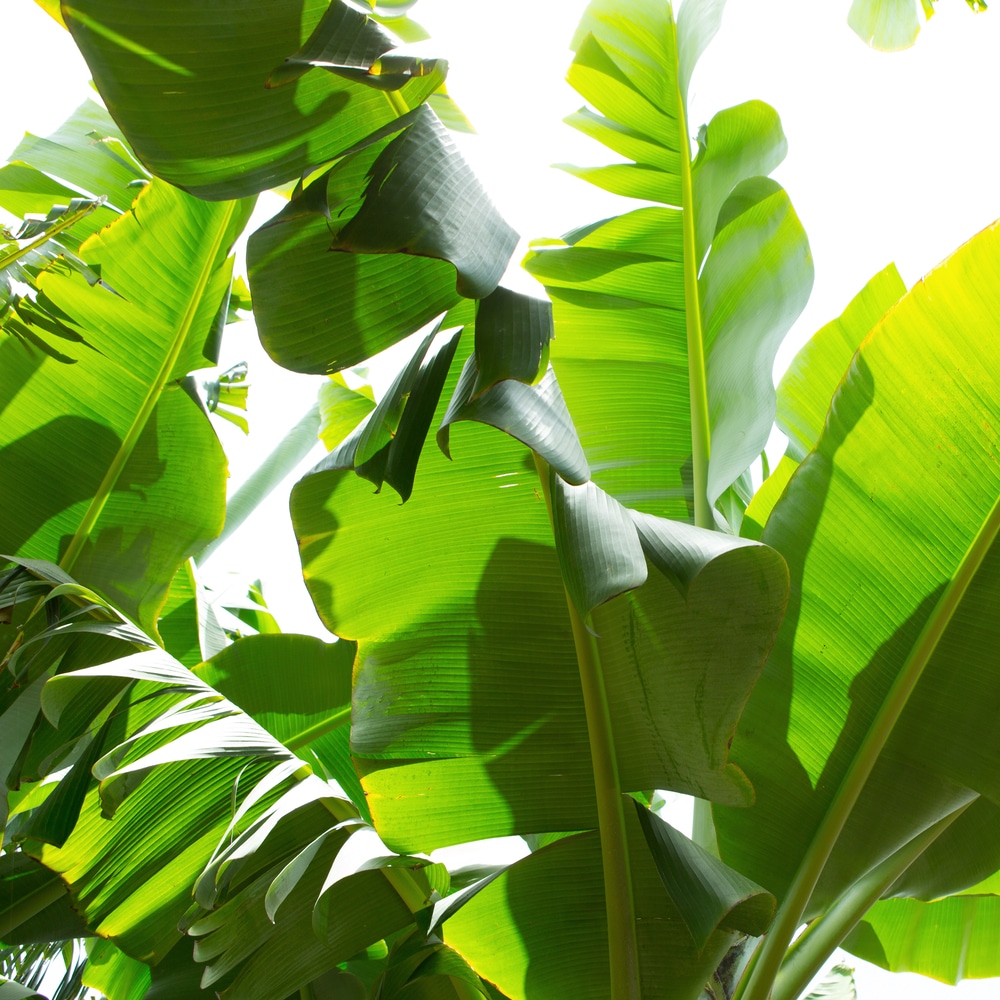
While it’s uncommon for a banana tree to regularly produce fruit indoors as constantly as it does outdoors, it can still happen. That’s not to say that fruit is all this tree has to offer; in fact, banana trees make absolutely beautiful houseplants, offering a tropical, wanderlust aesthetic to your space. Banana trees do require a great deal of bright, indirect light every day, however, so if you haven’t got any room near a South or East, facing window, you may not reap the benefits of a fruiting tree.
Being a tropical plant, banana trees need plenty of humidity and water. Their soil should never be allowed to dry out entirely, and they should be in a space that has at least 40% humidity year-round. Fertilize a banana tree once every 2-3 months for healthy growth, and watch out for pests like mealybugs and spider mites that often ride home from the nursery.
Bird of Paradise
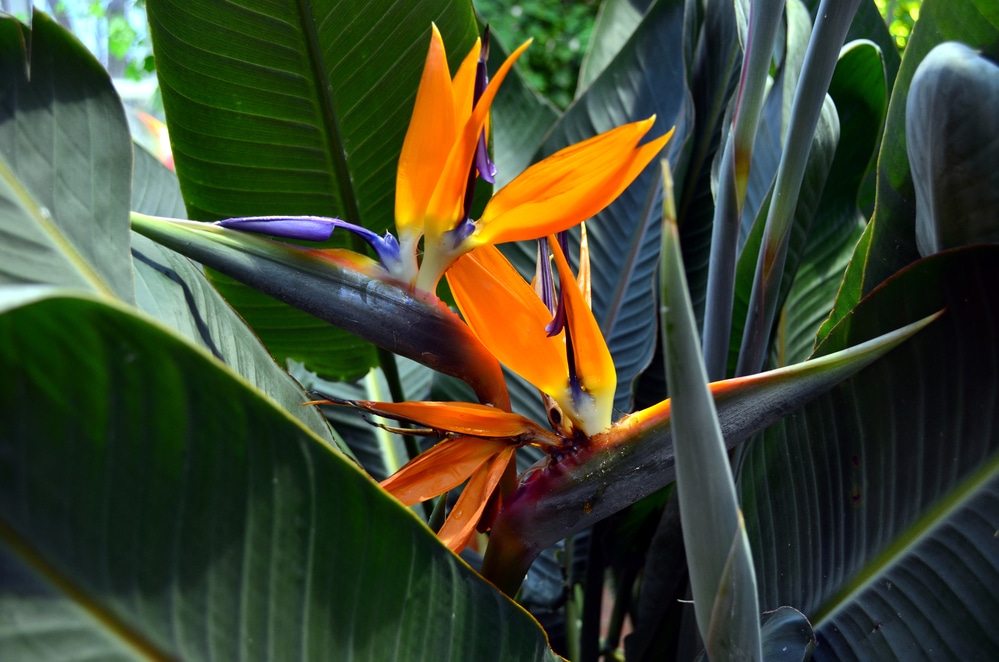
Like its many tropical counterparts, bird of paradise makes an elegant addition to your decor, and with proper care, it can even bloom radiant colors from orange and blue to bright white. These plants require several hours of bright, indirect light every day, but some varieties can easily burn if they’re placed directly in a window. This is another great option for a bright sitting room or home office.
These plants prefer high humidity, so a pebble tray or humidifier can make all the difference. Bird of paradise should be fertilized once every 2-3 months but can be fertilized less throughout the dormant season. Be sure to give the leaves a good wash when they begin to gather dust, so the plant can continue to absorb energy from the sun’s rays.
Calathea Orbifolia

If you tend to overwater more often than you underwater, this plant is for you, but you might want to invest in a self-watering planter because calatheas tend to be a bit dramatic when they’ve run out of water or end up soaking in it. Other than the occasional moisture tantrum, though, calathea orbifolia is capable of growing huge, luxe leaves with striking patterns that catch sunlight in a unique way.
These plants should be kept in medium to bright indirect light, but they won’t tolerate full sun or low light. Make sure to either mist the leaves every day or run a humidifier close by to maintain adequate humidity. Dry, crispy leaf edges can be a sign of low humidity or intense light, so watch for the signal; calatheas will always tell you when something’s wrong. That’s part of what makes them a fun and interesting large-leafed houseplant.
Chinese Evergreen
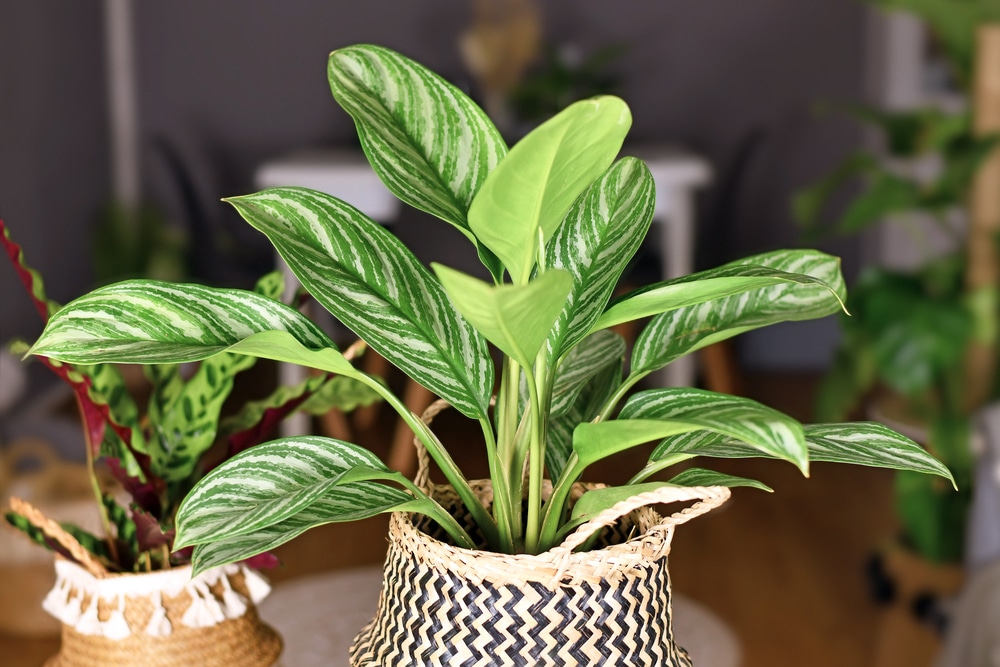
These plants were once incredibly popular in the United States but were forgotten about when the succulent craze hit. They’re making a comeback, though, and Chinese evergreens are the perfect plant for almost any room, so long as they receive some regular care and attention. The leaves of Chinese evergreens can grow quite large, so they must be misted and dusted regularly.
As a tropical plant, Chinese evergreens need some humidity to thrive. Self-watering pots are great for these plants, since they hold water below the roots, rather than in the roots. Interestingly, Chinese evergreens can do well in low-light rooms with artificial light or windows with light-colored walls. Be sure to trim away dead or dying leaves, which can make a gooey mess if they’re left for too long. Fertilize them once per month during the growing season to ensure even, healthy growth.
Colocasia (Elephant Ear)
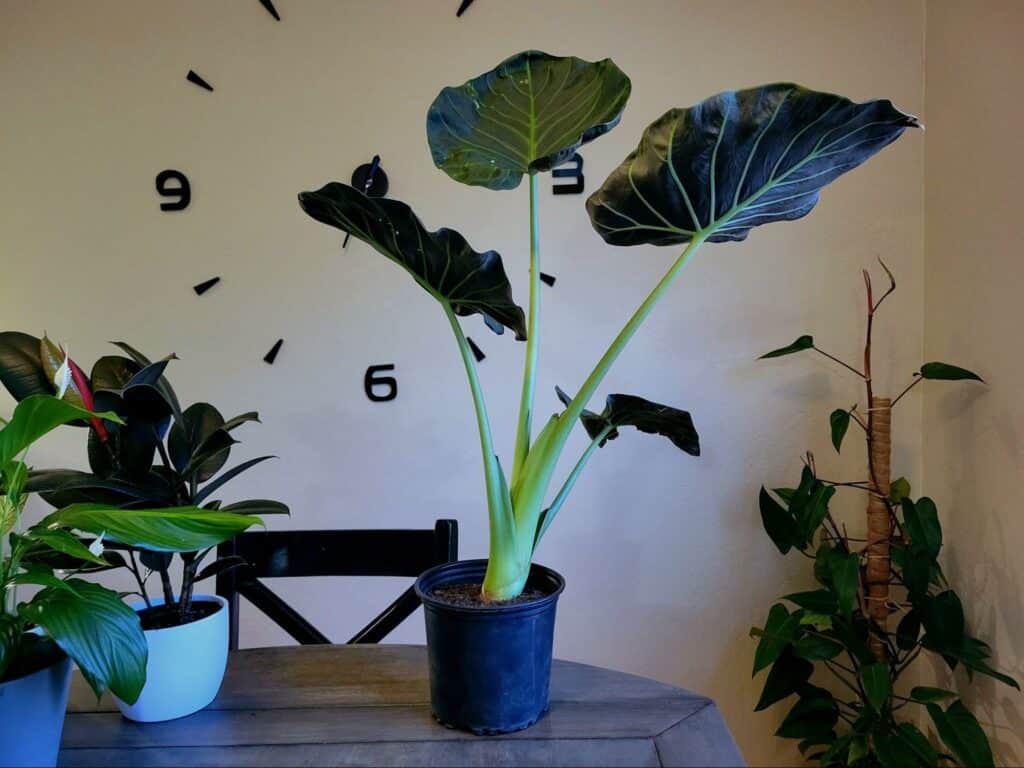
Believe it or not, there are actually quite a few different types of colocasia out there. Many of them grow smaller leaves in indoor climates, but a few can grow to have very large leaves with enough sunlight and humidity. Colocasia plants typically bear elongated leaves that droop down from their petioles in solidarity.
These plants like it warm and humid, so finding the right place for them can be tricky- especially since they don’t love direct light. However, they can be supplemented with a humidifier in a corner adjacent to a window, in a bathroom with skylights, or even in a home office, so long as you provide the humidity. Don’t let the temperature fall below 45 degrees Fahrenheit to prevent your colocasia from entering into dormancy.
Fiddle Leaf Fig
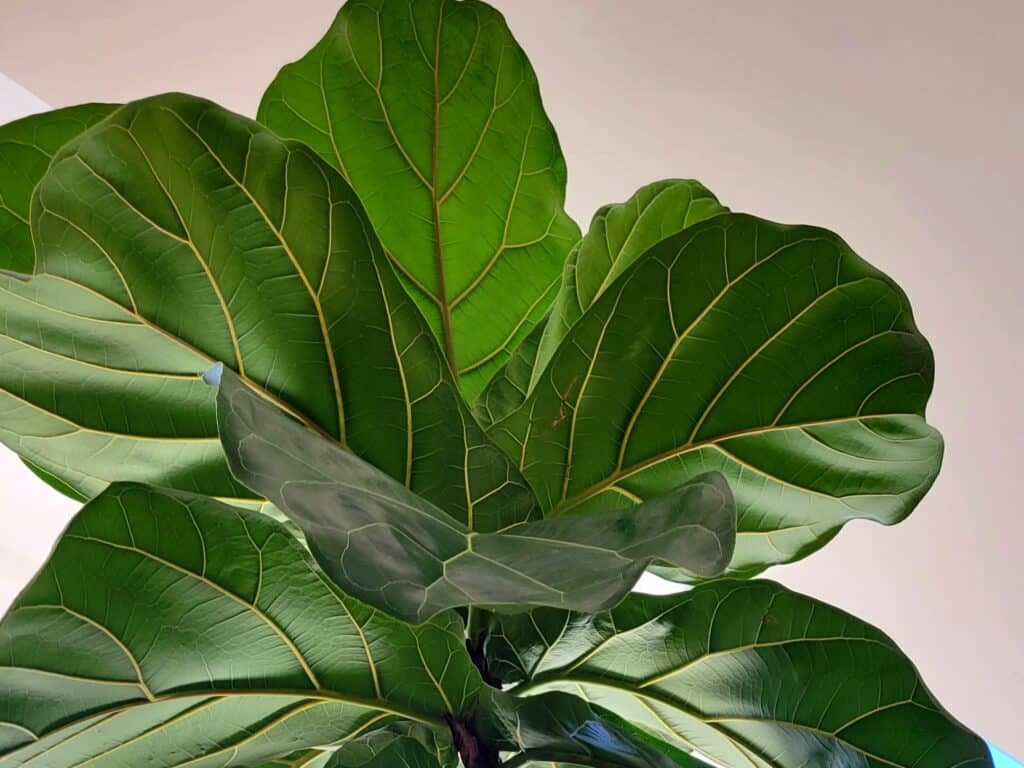
If you’re cringing at this plant on our list, it’s okay, we get it. But these plants really just need a little more love and care than some to thrive, and routine is key. Fiddle leaf figs are the darlings of green thumbs everywhere, but we’ll admit, they can be fussy. All it takes is some dedication, indirect light, and the right amount of moisture to get these guys to thrive.
If you’ve ever experienced a fiddle leaf fig dropping leaves, there’s a really good chance it was due to a lack of proper humidity (or underwatering). They can’t survive without lots of moisture, but if you have a humidifier or s spray bottle and a daily routine, you’re good to go. Try not to neglect them too long, though; overwatering to compensate for serial underwatering is exactly how to kill one of these pricey beauties.
Majesty Palm
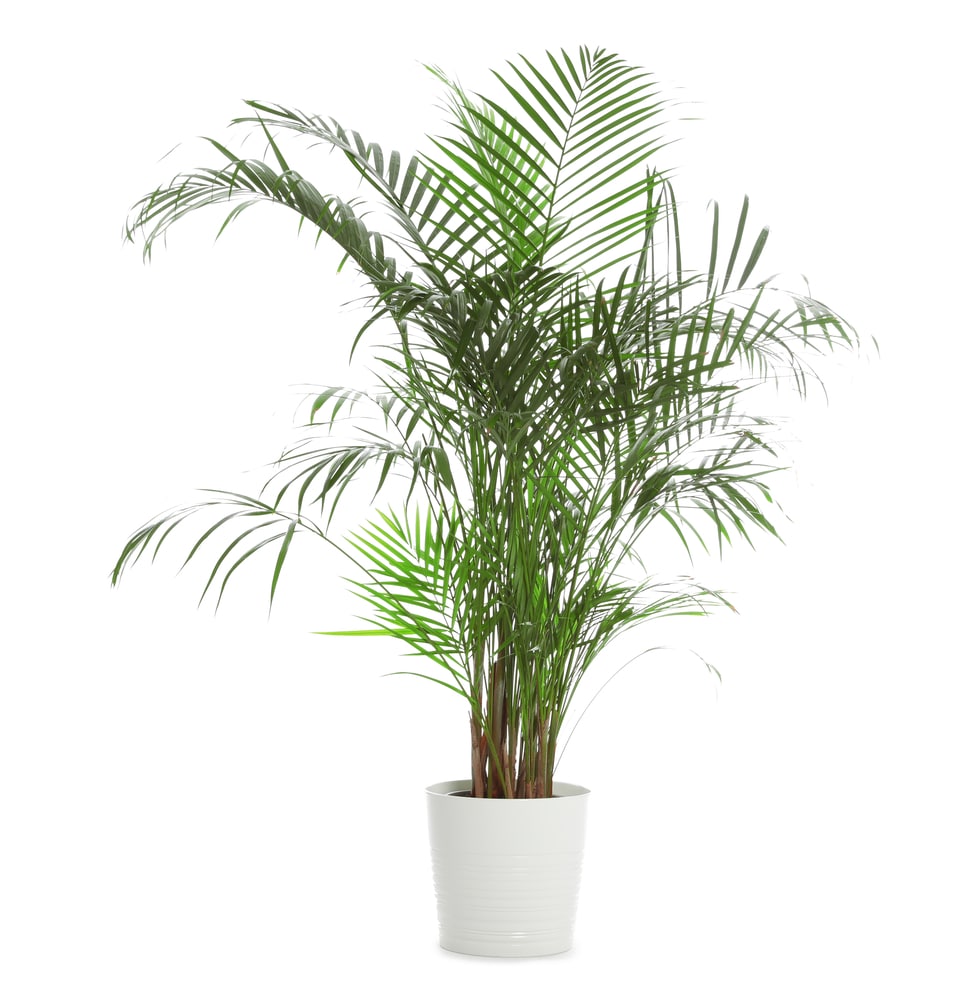
Majesty palms get huge. But not just huge; they can easily outgrow their space if you’ve got low ceilings, so this is one to avoid unless you have at least ten-foot ceilings. It can help to trim and prune them back, but that only goes so far- and it isn’t healthy for them to be cut back every time they work hard to make a new frond.
However, if you do have the space, majesty palms are a timeless large-leaf foliage plant that can elevate a room instantly. Toss in some boho macrame decor and you’ve got an island paradise aesthetic. They’re easy to care for, too: just give them plenty of light and water, and they’ll happily grow in their new space. Fertilize them once a month during the growing season, but only once over the dormant season.
Monstera Deliciosa

We know this plant is the main reason you’re here, but we don’t judge. If you’re late to the trend, fret not; monsteras are another timeless plant that won’t fall out of style anytime soon. They’re also one of the most rewarding plants to grow since it can take a long time for new leaves to form during the growing season.
Whether you opt for a moss pole or a trellis, though, your monstera will need support. Once they grow tall enough, these plants will topple over (and it is heartbreaking). If large leaves are what you’re after, be sure to provide lots of humidity. Mist them heavily every day, or place them in a room that’s dedicated to humidity-loving plants. The more light the leaves get, the bigger they will grow; however, don’t place them in direct sunlight, which can burn the leaves and cause some very unappealing brown and yellow splotches.
Peace Lily
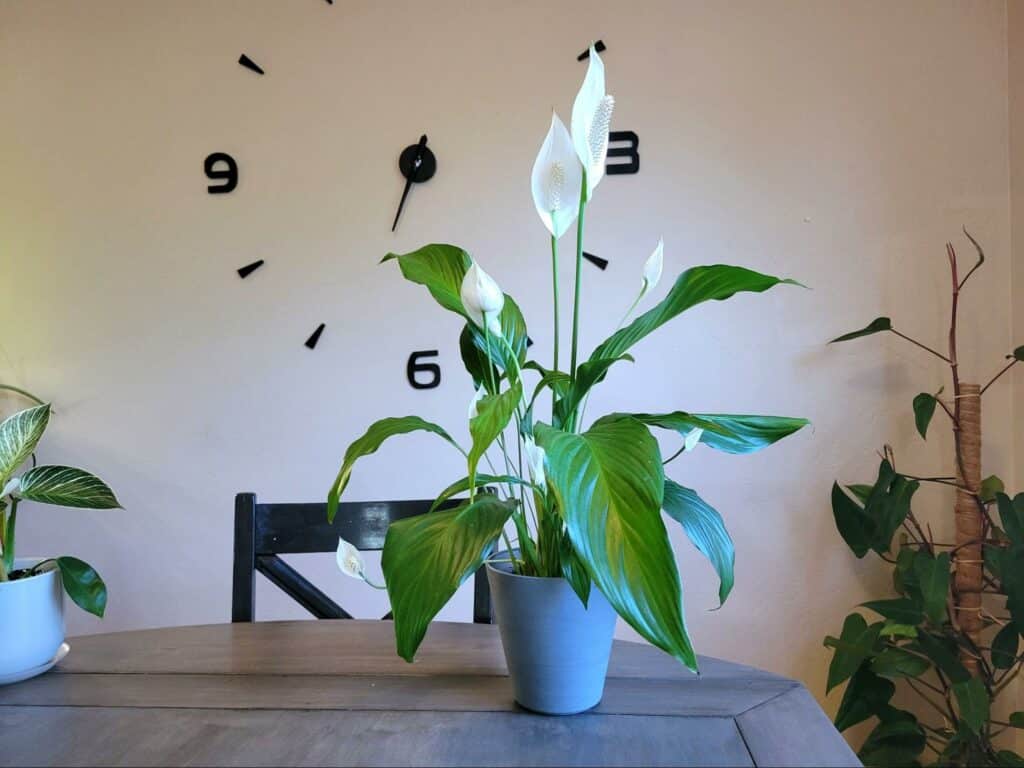
Water-loving peace lilies are perfectly quaint and fun on their own. Though they may start out small, their leaves can grow to be humongous. What’s great about peace lilies is that if they’re happy enough to grow large foliage, they’re happy enough to bloom consistently, so you’ve always got bright flowers going on. Watch out if you have pets or children, though, because peace lilies are especially toxic to them and should never be consumed.
Too much light can easily burn leaf edges, but too little will cause leaves to grow in smaller. It’s best to experiment with a plant like this by leaving it in a different spot every month until you find a spot that encourages lush, deep green leaves.
Philodendron Gloriosum
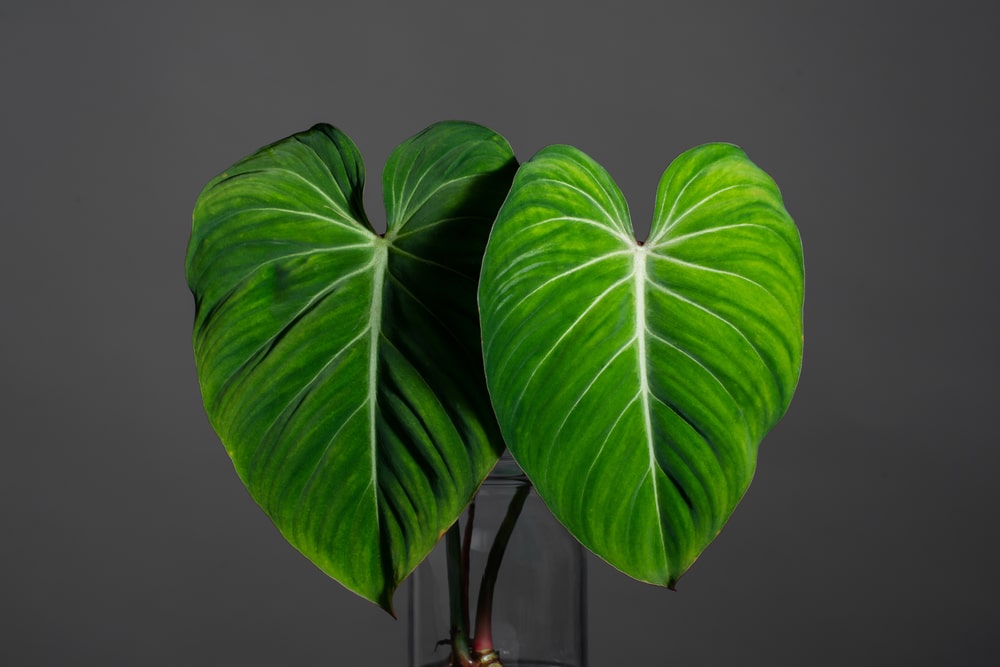
If you’re a fan of velvety-soft leaves, this philodendron is perfect for you. Featuring large, deep green leaves, this plant is as luxe as it gets. It looks amazing in vintage or modern decor, and will do well in a wide range of environments. Though it still needs some humidity, philodendron gloriosum doesn’t need a ton of it; a pebble tray full of water nearby is usually enough. Be careful if you have pets, though, as this plant is quite toxic to both pets and people if ingested.
As for light, this plant will tolerate moderately low light, but it does need bright, filtered light to produce new leaves. Water frequently enough that the soil never dries out entirely, but do allow it to dry at least halfway down the pot before watering again to prevent root rot. You should fertilize your philodendron gloriosum at least once a month with half-strength fertilizer during the active growing seasons.
Philodendron selloum
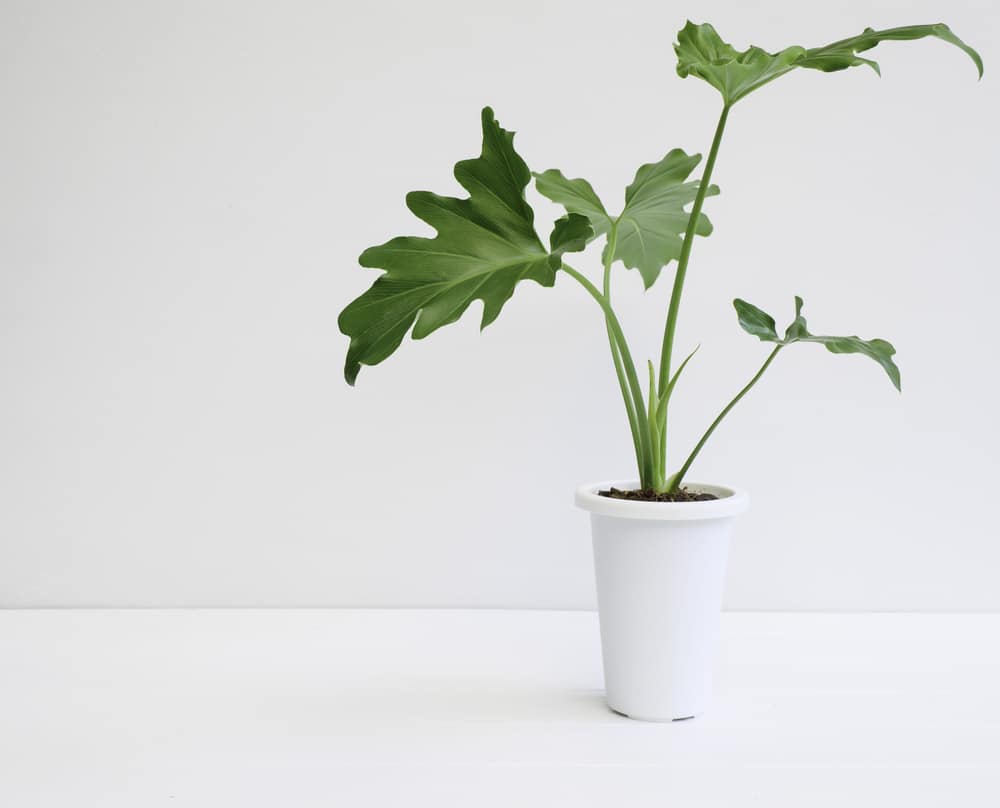
With huge, emerald green leaves full of unique striations, philodendron selloum is one of the most coveted large-leaved indoor plants on the market. Its foliage can grow enormous, and the plant itself can grow all the way up to a twelve-foot ceiling, so be sure you have lots of overhead room for this one to grow to its full potential.
As it is a philodendron, and philodendrons love humidity, it’s a good idea to provide some sort of humidity, from a daily misting to a humidifier or a large pebble tray full of water nearby. Philodendron selloum also needs quite a bit of bright, indirect light, but it’ll burn fairly quickly in full sun. A sheer curtain or adjacent corner to a window would make great spots. Fertilize once per month using a half-strength aroid fertilizer during the active growing season, and never allow the soil to dry out entirely.
Philodendron Xanadu
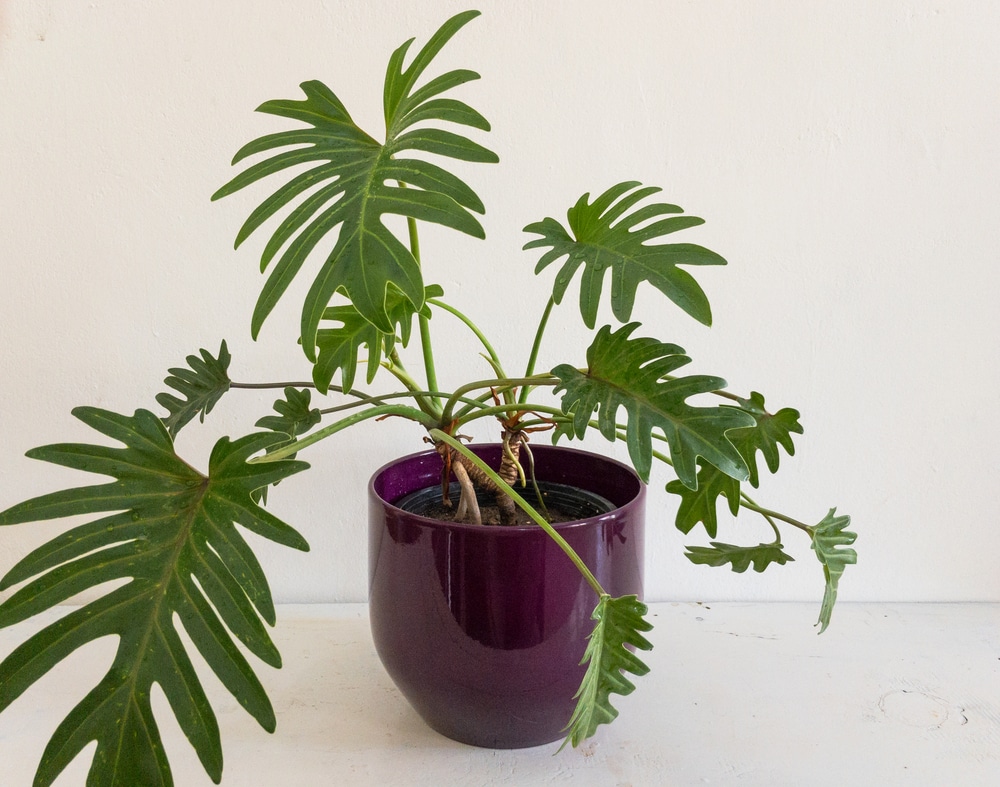
Very similar to the philodendron selloum, philodendron xanadu is a slightly different variety that tends to grow more leaves per plant. It grows tall as well, but this plant can grow to be very wide, so it should be placed in an open space that allows it the freedom it needs to grow into a large, beautiful plant.
This philodendron also happens to grow more aerial roots on average than most other species, so be prepared to provide lots of humidity. A great way to support the aerial roots and the plant’s need for high humidity is to install a moss pole that gets watered frequently. The moisture will evaporate from the moss creating humidity, and the aerial roots will dive into the moss for the moisture they need. Fertilize it like any other large-leaved philodendron.
Rubber tree
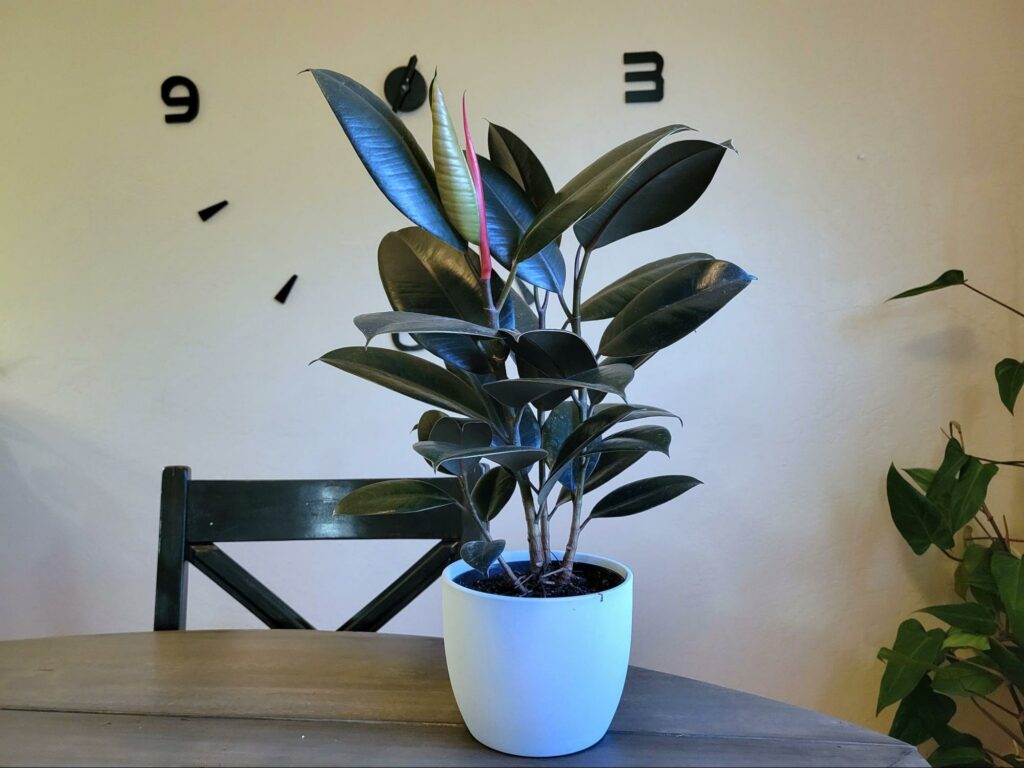
Another fun houseplant with large leaves is the rubber tree plant. Believe it or not, these plants grow as epiphytic vines in their natural habitat, and the leaves get big. With enough humidity and sunlight, the possibilities are endless. One common mistake that people often make is potting these plants in soil that doesn’t drain well. They prefer soil that’s a bit chunkier, but still maintains moisture, like an aroid mix.
During the growing season, this plant shoots up. It can reach heights of 20 to 30 feet if left unchecked, but if you’ve got ceilings lower than that (as most of us do), they won’t get nearly as tall. You can always lop off the top to create a wide plant with outreaching branches, which is a unique and creative look for these trees. Water them regularly without letting the soil dry out, and fertilize them once a month with a half-strength all-purpose fertilizer.
Swiss cheese plant
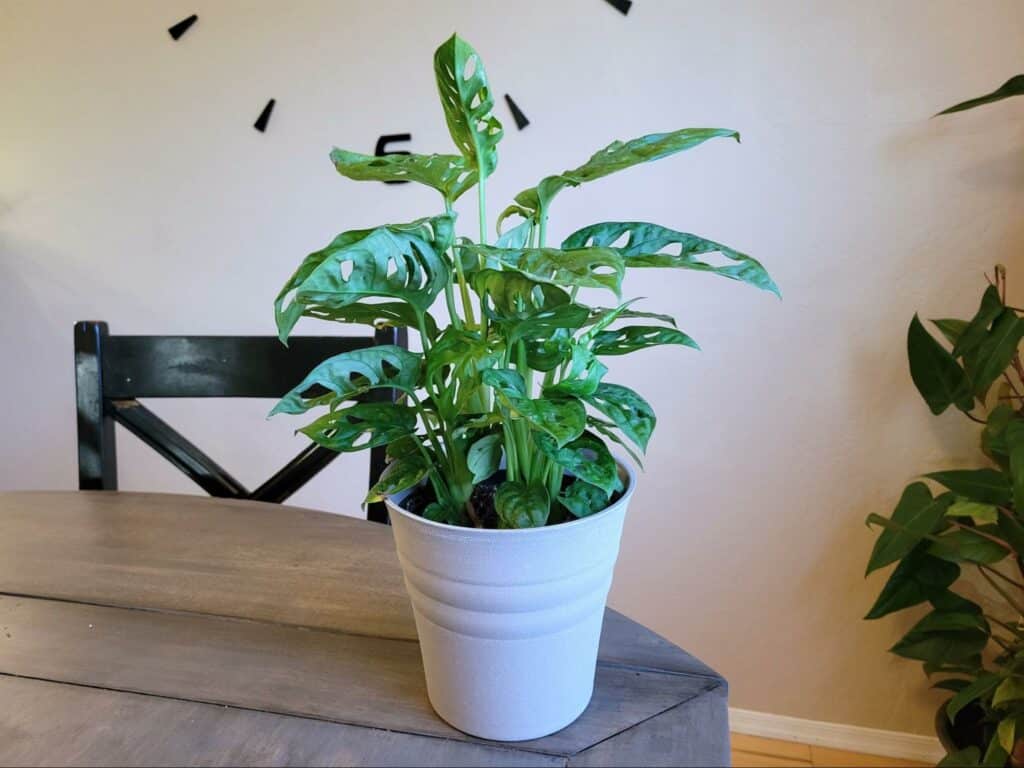
You may have seen them in small pots at your local department store, but the potential of a swiss cheese plant is far greater than commercial growers lead you to believe. In fact, this plant can grow into a long, trailing vine with broad leaves full of unique striations that add interest and depth to it. However, there are some parameters to follow in order to achieve large leaves.
Swiss cheese plants need plenty of water, both in the soil and in humidity form. Moss poles are an excellent way to get the plant to grow big leaves, but it takes some time if you’re starting from a small plant. Always provide at least 40% humidity, and be sure to fertilize it every two to three weeks with a half-strength indoor plant fertilizer. These plants are prone to root rot, so be sure never to leave water sitting at the bottom of the pot.
